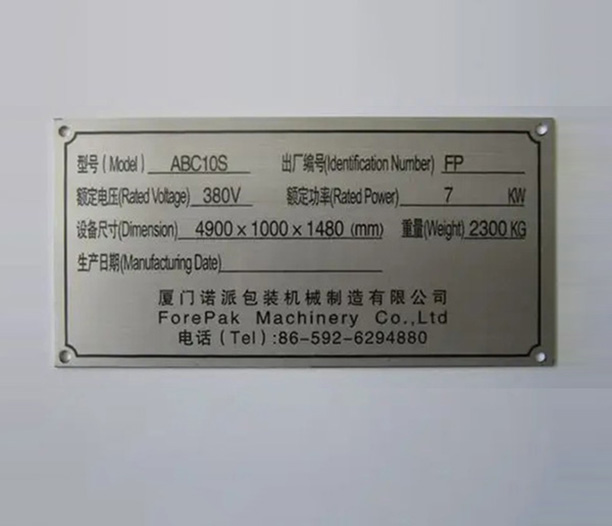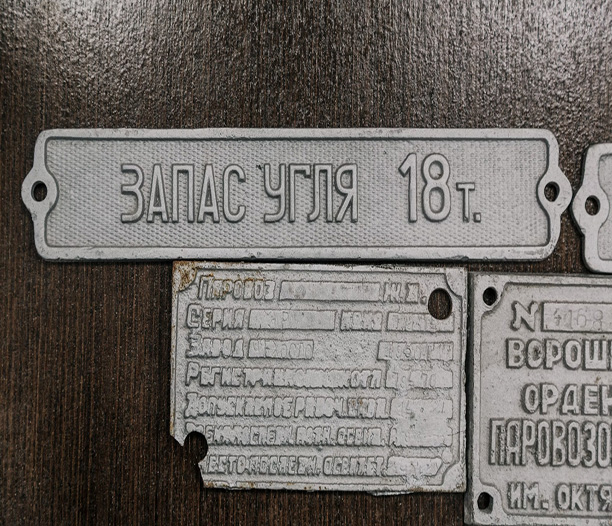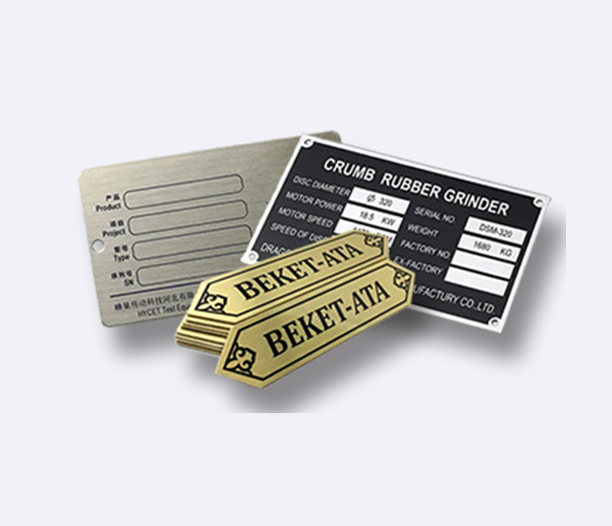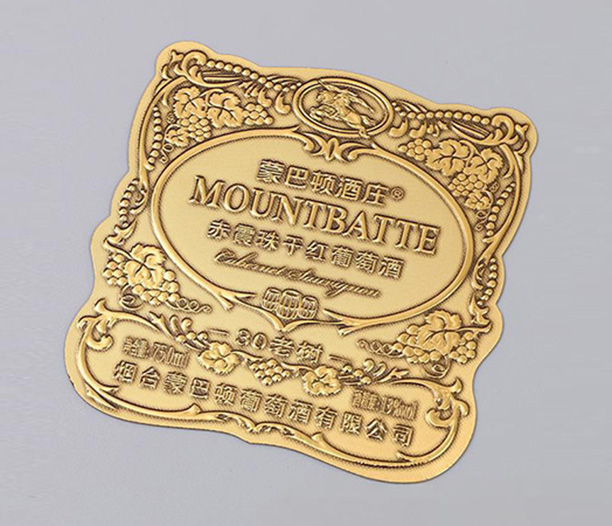Hey folks, let's talk about something that seems simple but actually makes a huge difference in the long run: nameplates and labels. You know, those tags on your machinery, equipment, control panels, outdoor signs, or even medical devices telling you what it is, who made it, safety warnings, or a serial number. When it comes time to pick the material, the big showdown is usually Stainless Steel Nameplates versus plastic options. It ain't just about looks – it's about survival, cost over time, and making sure that crucial information sticks around. Let's break it down, real talk.
Round 1: Durability & Lifespan – The Knockout Factor?
This is where Stainless Steel Nameplates absolutely shine. Think about it: stainless steel is tough as nails. It laughs in the face of scratches, scrapes, abrasion from tools or cleaning, and even impacts that would leave a plastic tag looking like it went through a shredder. You drop a wrench on it? Probably just a tiny ding. Do that to plastic? You might crack it or gouge big chunks out.

Plastic tags? Yeah, they can be decent, especially some engineered grades. But let's be honest, most common plastics (like acrylics or polycarbonates) just don't have the same inherent toughness. They scratch easier, they can become brittle over time (especially outdoors), and a sharp impact can spell disaster. If your equipment lives in a rough environment – a factory floor, a construction site, anywhere things get bumped or handled – Stainless Steel Nameplates are the undisputed heavyweight champs for lasting power. You're investing in a tag that should realistically outlast the equipment it's on.
Round 2: Weathering the Storm (Sun, Rain, Chemicals, Oh My!)
Okay, so your nameplate ain't living a sheltered life indoors? This round gets critical. Stainless Steel Nameplates are legendary for their environmental resistance. We're talking:
- Sunlight (UV): Zero worries. Stainless doesn't fade, yellow, or become brittle from UV exposure. Plastic? Big problem. Many plastics turn yellow, fade significantly, and get brittle after years in the sun. That crisp white lettering on a plastic tag? Might be a sickly yellow or barely readable after a few harsh summers.
- Moisture & Corrosion: Stainless steel, especially grades like 304 or 316, is practically born for this. It resists rust and corrosion incredibly well, even in salty coastal air or constant humidity. Plastic doesn't rust, obviously, but it can warp, absorb moisture (leading to issues), or support mold/mildew growth in damp conditions. Stainless Steel Nameplates handle wet environments with ease.
- Chemicals & Solvents: This is massive in industrial settings, labs, or anywhere cleaners are used. Stainless Steel Nameplates shrug off a vast array of oils, greases, fuels, acids, alkalis, and industrial solvents. Many common plastics? They can craze, crack, discolor, melt, or become sticky when exposed to harsh chemicals. If your tag might get splashed with something nasty, stainless steel is the safe, reliable bet.
- Extreme Temperatures: Stainless handles both high heat (think engine compartments) and freezing cold far better than most plastics, which can warp, melt, or become extra brittle.
Round 3: The Price Tag – Upfront Cost vs. Total Cost of Ownership
Alright, let's talk dollars and cents. Upfront? Yeah, plastic tags are almost always cheaper. Sometimes significantly cheaper, especially for simple designs or large quantities. If you need a basic indoor label for something that never gets touched or exposed, plastic might win on initial budget.
But... hold on. This is where Stainless Steel Nameplates start looking like a smarter investment. Think total cost of ownership:
- Replacement Costs: How often will that faded, cracked, brittle, or unreadable plastic tag need to be replaced? Every replacement means labor (finding the part, ordering, installing) and material cost all over again. A single Stainless Steel Nameplate often lasts decades without needing a refresh.
- Downtime & Errors: A failed nameplate – one where a safety warning faded, a serial number is gone, or a part number is unreadable – can cause serious headaches. It can lead to maintenance mistakes, ordering the wrong part, safety hazards, or equipment downtime while someone figures things out. That costs real money, potentially big money compared to the initial price difference. Stainless Steel Nameplates drastically reduce this risk.
- Professionalism & Brand Image: A faded, cracked plastic tag looks cheap and neglected. A crisp, durable Stainless Steel Nameplate signals quality, permanence, and attention to detail. That impacts how customers and users perceive your product or facility.
So, while plastic wins the sprint on day one, Stainless Steel Nameplates are built to win the marathon, saving you money and hassle year after year.
Round 4: Looks & Feel – Perception Matters
Beyond just surviving, how does it present? Stainless Steel Nameplates have a distinct, professional, high-quality aesthetic. That brushed or polished metallic finish screams durability and precision. It feels solid and substantial in the hand. You can achieve really sharp, crisp etching, engraving, or printing on stainless, creating a premium look.
Plastic offers more variety in colors and can be made translucent, which is great for backlit panels. Modern printing on plastic can look very good initially. However, as mentioned, that color will often fade, and the surface can get scratched up, dulling the appearance over time. It often feels lighter and, well, more plastic-like. If conveying a sense of ruggedness, permanence, or high-end quality is important for your application, Stainless Steel Nameplates deliver that message powerfully.
Round 5: Going Green – The Environmental Angle
Sustainability is on everyone's mind. Here's the scoop: Stainless Steel Nameplates are essentially 100% recyclable. At the end of their incredibly long life (which might be measured in decades), the metal can be melted down and reused endlessly without losing its properties. It's a true cradle-to-cradle material.
Plastic? It's complicated. Recycling infrastructure varies wildly, and many nameplate plastics (especially laminated or coated types) are difficult or impossible to recycle effectively. Even recyclable plastics often downcycle into lower-grade products. Plus, the production of virgin plastic relies heavily on fossil fuels. While plastic tags might be lighter to ship (a minor plus), the long-term environmental edge, considering longevity and end-of-life, definitely leans towards Stainless Steel Nameplates.

So, When Do You Pick Plastic? It Has Its Place!
Look, I'm not here to trash plastic completely. It absolutely has valid applications where Stainless Steel Nameplates might be overkill:
- Short-Term/Disposable Items: If the product itself has a short lifespan, cheap plastic tags make sense.
- Strictly Controlled Indoor Environments: Office equipment, consumer electronics interiors, light-duty indoor panels where there's no abrasion, chemicals, or UV exposure.
- Budget-Driven Projects with Low Risk: Where the absolute lowest initial cost is the only priority, and failure consequences are minimal.
- Backlighting Needs: Plastic is often the go-to for tags requiring illumination from behind.
- Extremely Complex Shapes/Forming: Plastic can sometimes be molded into intricate 3D shapes more easily than metal.
The Bottom Line: Making the Smart Call
Choosing between Stainless Steel Nameplates and plastic isn't just about picking a material; it's about understanding the demands of the application and the total value over time.
- Need something that can take a beating, laugh off the weather, resist chemicals, look professional for decades, and save you money on replacements? Then Stainless Steel Nameplates are your clear winner. They are the workhorse, the long-term investment, the solution for anything that needs to survive the real world. Think industrial machinery, heavy equipment, marine applications, outdoor signage, medical instruments, aerospace, chemical plants, food processing – anywhere toughness and longevity are non-negotiable.
- Got a simple, indoor, low-impact application where cost is king and lifespan isn't a major concern? Plastic might suffice. Just go in with your eyes wide open about its limitations, especially regarding UV fading and chemical vulnerability.
Don't just think about the tag you're putting on today. Think about the tag that needs to be readable, intact, and doing its job reliably 5, 10, or even 20 years from now. In most demanding scenarios, that kind of performance and peace of mind is exactly what you get with Stainless Steel Nameplates. It's an upfront investment that pays off year after year in durability, reliability, safety, and a professional image. When failure isn't an option, stainless steel is the material that delivers.






